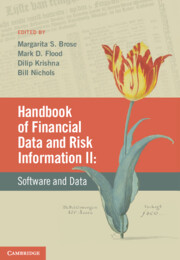Book contents
- Frontmatter
- Contents
- List of contributors
- Preface
- VOLUME II: SOFTWARE AND DATA
- PART IV DATA OPERATIONS IN FINANCIAL INSTITUTIONS
- 15 Financial market participants
- 16 Functional model for financial data and risk information
- 17 Financial institutions' data requirements
- 18 US residential-mortgage transfer systems: a data-management crisis
- PART V DATA MANAGEMENT TECHNOLOGIES
- PART VI IMPLEMENTATION OF DATA AND ANALYTICS PROGRAMS
- Index – Volume II
16 - Functional model for financial data and risk information
from PART IV - DATA OPERATIONS IN FINANCIAL INSTITUTIONS
- Frontmatter
- Contents
- List of contributors
- Preface
- VOLUME II: SOFTWARE AND DATA
- PART IV DATA OPERATIONS IN FINANCIAL INSTITUTIONS
- 15 Financial market participants
- 16 Functional model for financial data and risk information
- 17 Financial institutions' data requirements
- 18 US residential-mortgage transfer systems: a data-management crisis
- PART V DATA MANAGEMENT TECHNOLOGIES
- PART VI IMPLEMENTATION OF DATA AND ANALYTICS PROGRAMS
- Index – Volume II
Summary
Background
This chapter defines a generic, functional business model for a typical financial institution and the way any financial institution creates, utilizes and maintains data related to risk. The model is focused on the types of data required within financial organizations to define and manage risk and on the business processes that create and consume these data. Underlying the model is the premise that financial data and risk information are created, consumed and matured by nearly every function in a financial institution.
Throughout this chapter we will be utilizing the model organization for thinking about the forms of data utilized by financial institutions. The model is meant to be applicable to any type of financial institution including banking, investment management, investment banking, insurance and securities organizations. To illustrate how business processes create and consume data, we will construct a simple model organization consisting of a Financial Holding Company with four consolidating subsidiaries. Each subsidiary is engaged in defined lines of business conducted in limited transaction types. We will assign a few key employees to each subsidiary and will examine the processing architecture and how data flow through the architecture as each transaction is processed. In addition, we will examine, at the highest level, each subsidiary's regulatory and risk environment to illustrate the use of data in the infrastructure layer to monitor and report on business activities. Finally we will conclude with some illustrative ways that the model can be utilized.
- Type
- Chapter
- Information
- Handbook of Financial Data and Risk Information IISoftware and Data, pp. 33 - 49Publisher: Cambridge University PressPrint publication year: 2014



